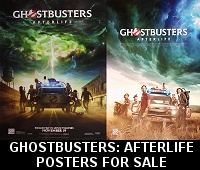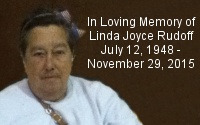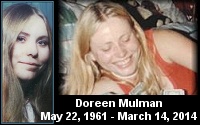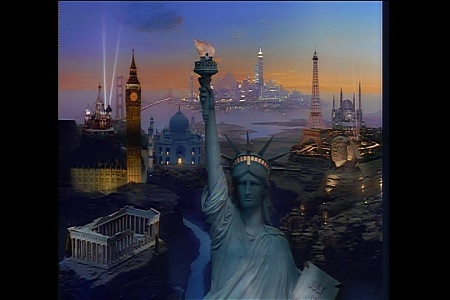Paul's Pet Peeves - Letterboxing & Pillarboxing DVDs (Bonus: Robin Williams DVD Edits)
By Paul Rudoff on May. 1, 2023 at 6:50 PM in Home Video, Public Service Articles

Paul's Pet Peeves series of articles in which I express my feelings about some little thing that bothers me. Today's article is about the use of 4:3 Letterboxing & 16:9 Pillarboxing on DVDs. As a bonus, I will also list all of the edits on the Robin Williams: Live on Broadway DVD. Read on to find out more...
Over the past 25 years, I have amassed a rather large collection of videos on physical disc media (DVDs, Blu-rays, and 4K UHDs), which is in addition to all of the VHS tapes I've collected since 1989. While I don't claim to be a video expert, and I will try to keep things as simple as possible in this article so none of you get confused by anything, I have become quite familiar with the basic techniques of presenting movies and television programs on home video in various aspect ratios to fit various television sizes.
Now, before I really get into this, I think it would be wise to give a basic explanation of the three ways of padding video content to fit a different-shaped screen. Letterbox adds blackness on the top and bottom of the image, Pillarbox adds blackness on the left and right of the image, and Windowbox adds blackness on all four sides of the image.
The two general aspect ratios of television screens are 4:3 (1.33:1) and 16:9 (1.77:1). The people who created the DVD format in the mid-1990s were smart enough to realize that the format needed to work for the 4:3 televisions of the day, but should also be forward-compatible with the 16:9 televisions that were in their infancy at the time. Their solution was to make DVD an anamorphic format, which in simplest terms, means that the image is distorted so as to use the full video resolution, but the DVD player will reshape it back into the proper 4:3 or 16:9 aspect ratio when displaying it. The maximum DVD resolution is 720x480 for countries that use NTSC, such as the United States (PAL regions have a resolution of 720x576). This standard definition anamorphic resolution will be displayed as 640x480 for 4:3 content, and 852x480 for widescreen content. (Note: High-definition formats of Blu-ray and 4K UHD present video in the sizes of 1920x1080 and 3840x2160, respectively. Since these resolutions use "square pixels", and are not anamorphic, letterboxing and pillarboxing is necessary for any video that does not naturally fit the entire 16:9 screen. That said, standard definition content can be included on a Blu-ray disc, where it will be in the same 720x480 resolution as DVD.)
Your television (or computer or other device) is smart enough to add blackness where necessary, so that there isn't a need to add blackness in the DVD video itself. (For the sake of keeping things simple, let's focus solely on content that was created specifically for 4:3 and 16:9 screens and ignore all of the movies that are in wider aspect ratios, such as 1.85:1 and 2.35:1, which need to be letterboxed, even on an anamorphic widescreen DVD.) In the late 1990s, if you were to watch a 16:9 anamorphic widescreen DVD on a 4:3 television, the television would add blackness on the top and bottom so that you could see the image properly. If you watch that DVD on a modern 16:9 screen today, it would fill your entire screen. Conversely, a 4:3 DVD that filled the entire screen back in the day, would still be displayed properly on a modern 16:9 screen because the television would add blackness on the sides.
In both cases, there is absolutely no need for the studio to re-format the video to fit either screen. When the studio adds blackness to the video itself, it presents several problems. For starters, when you view that DVD on the screen size for which it was NOT originally formatted for, the image will be windowboxed! The bottom row of the sports car comparison image in this article shows what windowboxing looks like. Nobody wants to have blackness on all four sides, because then the actual image is in a tiny little display area.
Windowboxing is the biggest problem with watching a 4:3 letterbox DVD on today's HDTVs. You will definitely notice that something is "wrong". I try to avoid buying old 4:3 letterbox DVDs and have been making efforts to replace the ones I have with Blu-rays or foreign-released anamorphic DVDs (since I have a region-free player). All of the examples below will show you the image as it exists on each disc, scaled down to 450x300 to fit this page, but you can click on each for the original 720x480 DVD image.

For Who Framed Roger Rabbit (1988), I have the original 1999 DVD release (in 4:3 letterbox) and the 2003 Vista Series DVD release (in 16:9 anamorphic widescreen). On the 1999 DVD, thanks to all of the added blackness at the top and bottom, the 720x480 resolution has been brought down to approximately 720x351. That's a loss of 130 pixels in height.
The film is in a 1.85:1 aspect ratio, so all copies will have a tiny bit of blackness at the top and bottom, as you can see in the anamorphic DVD. It's also interesting to see that Disney actually windowboxed the anamorphic DVD with a tiny little bit of blackness also added to the left and right sides. If I take out the blackness from all sides, I'm left with a 708x462 image...
...which will be displayed anamorphically at roughly 852x480 on my television.
A lot of the 4:3 letterbox DVDs from the 1990s have really bad film transfers, but the one Disney used actually looks pretty good.
The anamorphic DVD is a little bit better looking, but not by much.
If you wanna see a more extreme example, let's look at a really wide film.

Conan the Destroyer (1984) was filmed in a 2.35:1 aspect ratio, which is quite wide and requires a great deal of blackness at the top and bottom, even on Blu-ray. Here, I will compare the 4:3 letterbox DVD from 1998 with the widescreen Blu-ray from 2011 which I reformatted to match what an anamorphic DVD would look it (if I had one). So, when Universal added more blackness for the 4:3 letterbox DVD, there wasn't much room left for the movie. The display area went down from 720x480 to a mere 720x271; a loss of 209 pixels. That's almost half of the height taken up by blackness.
If Universal made the DVD 16:9 anamorphic, the display area would have been 720x363. The movie would gain 92 pixels in height...
...and would look like this when displayed anamorphically on an HDTV.
As you can see, the wider the movie is, the less of it there is on a 4:3 letterbox DVD.
An anamorphic DVD would give you more picture area, but for a movie filmed in 2.35:1, there will still be some blackness at the top and bottom.
When watching one of these 4:3 letterbox DVDs on today's HDTVs, you can counter the windowboxing effect if your HDTV has a zoom function. Still, that's an annoyance that nobody needs... and one that won't be available to you if you happen to be viewing a 16:9 pillarboxed image on an old 4:3 television today. Yes, I know that the likelihood of that is very slim, but I'm sure there are a few people out there who are even more of a dinosaur than I am :-)
Even worse than windowboxing is that adding the blackness in the video itself reduces the resolution - and the quality - of the content. DVDs are low-resolution as it is, but when the studio uses pillarboxing or letterboxing, the resolution lowers even more. Over the past year, I purchased two DVDs of 4:3 content that the studios quite stupidly put into 16:9 pillarbox frames: Robin Williams: Comic Genius (2018, Time Life) and Michael Jackson's Vision (2010, Sony Legacy). For Robin Williams, the actual resolution of the image goes from 720x480 down to 547x480. For Michael Jackson, it goes even further down to 530x480. That's a loss of 173 and 190 pixels, respectively. I have no idea what the teams working on either release were thinking. Are they idiots who didn't know that DVD is an anamorphic format, and not square pixels like Blu-ray? Were both projects originally intended for Blu-ray (where pillarboxing is necessary), and the Blu-ray was dropped in favor of DVD only? I think this might have been the case for Michael, as each music video is prefaced by a new 16:9 widescreen title card, and all music videos that were originally released in 4:3 letterbox have had the black bars at the top and bottom cropped off so they can be presented in 16:9 anamorphic widescreen (a practice that I do approve of).
I am fortunate enough to own two older Robin Williams and Michael Jackson DVDs which presents content that appears on the new DVDs in the original 4:3 fullscreen DVD format: Robin Williams: Live on Broadway (2002, Columbia Music Video) and Michael Jackson: Video Greatest Hits - History (Special DVD Edition) (2001, Epic Music Video). This gives me the ability to show you why 16:9 pillarboxing is BAD! I also get to compare the transfers on both old and new releases. All of the examples below will show you the image as it exists on each disc, scaled down to 450x300 to fit this page, but you can click on each for the original 720x480 DVD image. I am not reshaping them back into 4:3 and 16:9, which is how your television will display them. I want to show you how the image is encoded on the disc, which is the most important thing here.

For Robin Williams, I will focus solely on his 2002 HBO special Live on Broadway. On the 2002 DVD from Columbia Music Video (henceforth CMV), it is presented as 4:3 fullscreen...
...while Time Life's 2018 disc presents it in 16:9 pillarbox.
As you can see, the CMV DVD takes full advantage of the 720x480 DVD resolution, though the image is a tad dark.
The Time Life DVD wastes 173 pixels on blackness, which is why the image isn't as sharp as the CMV DVD. Notice how in the image above you can actually see the sweat droplets on Robin's forehead. The only positive is that Time Life brightened up the picture.
Now it's Michael's turn to take the stage...

For Michael Jackson, I will look at the Thriller (1983) and Black and White (1991) (DVD edit comparison) music videos as found on the Video Greatest Hits - History DVD released in 2001 by Epic Music Video, and the Vision DVD released in 2010 by Sony Legacy. The 2001 Epic DVD presents the videos in 4:3 fullscreen (though there is a tiny bit of blackness on the right side)...
...while the 2010 Sony disc presents them in 16:9 pillarbox.
Like with Robin, the original Epic DVD is a tad dark...
...while the newer Sony DVD is brighter and more colorful. Despite the unnecessary pillarboxing, I actually find the new DVD much nicer to look at. That's the benefit of it using a new transfer.
If you didn't know that Black or White was from 1991, this shot of Michael with Macaulay Culkin and Marliss Pugh (of Another Bad Creation) would clue you in.
I don't think I've seen any other image that screams "1990s!" more than this.
At least the special effects have held up pretty well 30 years later.
Since the Vision DVD uses a new transfer, it actually looks a tiny bit sharper, even though it loses 190 pixels in resolution.
I could forgive the 4:3 letterboxed DVDs that were produced in the late 1990s due to the prevalence of 4:3 TVs at the time, and the studios reluctance to put much effort into the then-new DVD format that they didn't know would be a success; though I still feel that every one should have been redone later from new widescreen masters to replace the original DVD releases. I can't forgive 16:9 pillarboxed DVDs made in the past 10-15 years. Just because most people DON'T have 4:3 televisions anymore, and won't see the problem pillarboxing presents when they watch the disc, doesn't mean that there isn't a problem with it.
NOTE: Pillarboxing 4:3 standard-definition (720x480) video on Blu-ray (as special features) is, unfortunately, so commonplace that it would make no sense to keep a list. However, I will include a brief list here of DVDs I have personally seen with pillarboxed video as the MAIN content:
- Robin Williams: Comic Genius (2018, Time Life)
- Michael Jackson's Vision (2010, Sony Legacy).
- Monty Python's Flying Circus: The Complete Series 1-4 Fully Restored (7-Disc, Green Case, Universal).
Bonus Feature: Robin Williams Live On Broadway DVD Edits
In 2018, Time Life released a fantastic collection of Robin Williams' comedy specials and TV appearances in a DVD set entitled Robin Williams: Comic Genius. Some of the discs from the full 22-disc set were released separately in cheaper 1-disc (just Off The Wall), 5-disc (all 5 HBO Specials), and 12-disc (All 5 HBO specials + 7 discs of USO shows and other stuff) configurations. Obviously, if you want to be totally stuffed on nearly every appearance Robin made on television, as well as his appearances at many USO shows over the years, and much more, you'll want the 22-disc set. That set does include several episodes of Mork & Mindy, which are a total waste if you already own the Complete Series set (where they are presented properly in 4:3 fullscreen). Since 95% of the content is from the old 4:3 TV days, no matter which set you buy, you'll be left with NEARLY EVERYTHING being presented incorrectly in 16:9 pillarbox format instead of the proper 4:3 fullscreen format. You won't notice a difference when viewed on a 16:9 television - you will see blackness on all sides if you view the DVDs on an old 4:3 television - but you will still be getting a poorer-quality product.
I recently purchased the 5-disc set from a big box retailer for $20, which gave me all five of Robin's HBO specials from 1978's Off The Wall to 2009's Weapons of Self-Destruction, along with some additional TV appearances, interviews, and promos. I already owned the original 2002 CMV (Columbia Music Video) DVD of 2002's Live on Broadway. All of the extras from the CMV disc, including the "Explicit Language" Easter Egg, are on the Time Life disc (though presented in 16:9 pillarbox). However, the Time Life disc is still the preferable version because the CMV DVD IS EDITED!
Live on Broadway (2003) on the original CMV DVD runs 1:38:47, while the Time Life DVD runs 1:39:35. The CMV DVD loses 42 seconds in edits (detailed below), but the Time Life DVD gains a 10-second legal text screen at the end ("© 2018 The Robin Williams Trust. All Rights Reserved" ). All but one of the edits was done to save money on music rights, which is ironic since the program was released by Columbia MUSIC Video, the home video brand for Sony's music-related home video releases. One edit was done to remove a Jewish slur, I suspect. Even more ironic is that the CMV DVD retains a licensed song during the end credits which the Time Life DVD removes; assuming CMV didn't ADD it. (I don't have a copy of the original HBO broadcast for comparison.) To cover most of the edits, the CMV DVD inserts a shot of Robin from behind. Click on the text in brackets below to view a video clip of the original portion. (WARNING: CLIPS FEATURE EXPLICIT LANGUAGE AND ADULT CONTENT.) For footage I pulled from the Time Life DVD, I reformatted it back into 4:3 fullscreen.
- 1:42cmv/1:42tl - (12 secs removed) After "Shakespeare with a strap-on", Robin remarks about being in the Broadway Theatre and makes jokes about Ethel Merman singing "I Like Big Butts" and Carol Channing singing "What if God was One of Us".
- 3:23cmv/3:35tl - (7 secs removed) After "You were Diana Ross, now you left it all behind", Robin sings "Jew me, sue me..." in the vein of a Michael Jackson song. I'm not sure why this was edited out, as it wasn't a real song. Maybe it was due to Robin's use of a Jewish slur, though given the adult nature of Robin's act, and the big TV-MA rating on the DVD cover, I would think viewers would know what to expect going in.
- 34:37cmv/34:55tl - (5 secs removed) After he mentions being able to carry a 4" blade on a plane pre-9/11, Robin breaks into a "West Side Story" song parody that sounds nothing like the real song.
- 44:30cmv/44:53tl - (5 secs removed) After he says, "They put 'W' out there, but they protected Cheney", Robin breaks out into "Me and My Shadow... Government".
- 47:01cmv/47:28tl - (7 secs removed) After singing "Oh, Kenny Boy, the feds, the feds are coming", Robin sings a parody of "Da Do Run Run" about Enron. The "Danny Boy" song parody was allowed to stay in (I guess the song is in the public domain), but the other one had to go.
- 49:46cmv/50:19tl - (6 secs removed) After he suggests playing Cat Stevens records all day, Robin breaks out into another song parody.
- 1:37:10cmv/1:37:46tl (audio alteration) - Ironically, the CMV DVD plays "One Love" by Bob Marley (or his son Ziggy Marley) during the end credits, while the Time Life DVD plays white noise (crowd murmurings).
I can't find a list of the content on the 12-disc and 22-disc Time Life sets, but The Digital Bits review lists everything found on the 5-disc set that I bought. Check that out if you want more information. Also, to learn more about aspect ratios, check out Widescreen.org, Rtings.com, and Red Shark News.
No feedback yet
Leave a comment
| « Superman: 5-Film Collection 1978-1987 (Christopher Reeve) 4K UHD Review | The Thing (2011) Steelbook Blu-ray Review » |







































